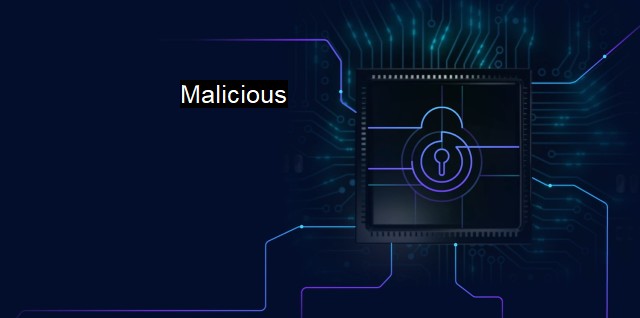What are Malicious?
Understanding Malicious Software: Risks, Types, and Prevention in Cybersecurity
"Malicious" is a term often used in the context of cybersecurity and antivirus software. The term is derived from the Latin word 'malitia', expressing a desire or intent to cause harm to others. When associated with cybersecurity, it pertains to an action or process that is designed deliberately to cause damage, infringement or invasion to a computer network, system, or a personal user's computer.Malware, a portmanteau of 'malicious' and 'software', is widely recognized within the scope of cybersecurity and antivirus technologies. This classification encompasses software that is produced specifically for harmful purposes. Typically, it consists of coding or scripted threats developed by wrongdoers to gain illegal access, infringe, exploit, or inflict harm on computer operations or data networks.
In today's highly digital world, malicious actors often design malware with an intention to create disruption, usually for personal gain or the sheer pleasure of exploiting or damaging an individual's or organization's computerized network or operations. Such motives include theft of financial or personal information, development of botnets, perpetration of fraud, or incursion of denial-of-service attacks, data breaches, and unauthorized network admittance. A surge of malware has been noticeable in this era of connectivity, emphasizing the critical need for robust cybersecurity practices and powerful antivirus software.
Antivirus, conversely, is an application developed to maintain a system's integrity and protect it from malicious software. Primary capabilities of antivirus software consist of regular system scanning, detection of invasive software, quarantine of threats and their effective removal. Antivirus technologies work by acknowledging known threats from an ever-expanding database of malicious software profiles, which are continually updated in line with the growing complexity of malicious cyber activity.
Antivirus software has invariably been an essential line of defense against malicious threats. And, the dynamic landscape and ever-evolving nature of cyber threats will only increase its importance. With cybercriminals increasingly targeting vulnerable systems and networks - exploiting weaknesses, spreading malicious threats, and stealing sensitive information, there is rising dependence on the apparatus of robust firewall systems, intrusion detection systems, and of course, antivirus software.
Malicious software is not limited to malware. Malicious activities can also be conceived in a cybersecurity environment in terms of phishing emails, nefarious websites, scams, and several other forms that are purpose-built to perpetrate harm to network systems or personal data. Therefore, as an essential aspect of cybersecurity mechanisms, specific measures such as user education, secure coding principles, regular updates, timely patching, robust passwords, multi-factor authentication, and using encrypted connections, in tandem with antivirus measures, increase system resilience against malicious activities.
'malicious' is a term that epitomizes the negative facets of the digital frontier, where cybersecurity and antivirus technologies endeavor to protect. In this broad spectrum of unending cyber threats like viruses, trojans, worms, adware, spyware, ransomware, and more, the term ‘malicious’ signifies harmful intent that violates trustworthy cyber spaces with debauch activities that pose significant challenges to individual, corporate, and even national security. These threats underscore the compelling need for us to have in-depth strategies that incorporate proactive threat intelligence, robust cybersecurity hygiene, and sophisticated technology for defense mechanism against the malignant world of malicious cyber threats.

Malicious FAQs
What is a malicious software?
A malicious software, also known as malware, is any program or code designed specifically to harm or disrupt computer systems, networks or devices.What are some types of malicious software?
Some types of malicious software (malware) include viruses, worms, trojans, ransomware, adware, and spyware.How can I protect my computer from malicious software?
You can protect your computer from malicious software by installing a good antivirus software with updated definitions, keeping your operating system and software up-to-date, avoiding suspicious emails or websites, and being careful when downloading files from the internet.What should I do if my computer is infected with malicious software?
If your computer is infected with malware, you should immediately disconnect it from the internet and run a scan with your antivirus software. If that doesn't work, you may need to reinstall the operating system or seek professional assistance from a cybersecurity expert.| | A | | | B | | | C | | | D | | | E | | | F | | | G | | | H | | | I | | | J | | | K | | | L | | | M | |
| | N | | | O | | | P | | | Q | | | R | | | S | | | T | | | U | | | V | | | W | | | X | | | Y | | | Z | |
| | 1 | | | 2 | | | 3 | | | 4 | | | 7 | | | 8 | | |||||||